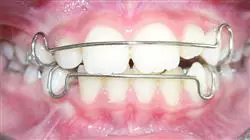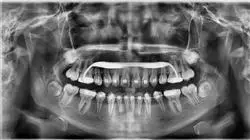University certificate
The world's largest faculty of dentistry”
Introduction to the Program
Improve your knowledge with this program where you will find first class clinical cases and materials. Improve the quality of your clinical practice through this Postgraduate diploma in Dentofacial Orthopedics”

Orthodontics was the first specialty within dentistry and the second after ophthalmology within the health sciences. In this sense, specialty is understood as the possession of a specific professional organization, literature and training. Its specific characteristics in diagnosis, type of treatment, objectives and scientific bases, require exclusive professional practice.
Together with orthodontic therapy, dentofacial orthopedic treatments are applied to optimize results and frequently enhance the rehabilitation of structures and improvement of their function.
The fundamental justification of the program is, therefore, to train professionals with adequate knowledge, skills, attitudes, values and competencies, ensuring they are able to serve society by satisfying its health demands, in terms of prevention, diagnosis and treatment, in an ethical, efficient and safe manner.
This professional must appreciate the need for lifelong professional development and continuing education, be able to efficiently utilize advances in knowledge and technology, and understand the central role of the patient in therapeutic decision making.
Expand your knowledge through the Postgraduate diploma in Dentofacial Orthopedics, in a practical way and adapted to your needs”
This Postgraduate diploma in Dentofacial Orthopedics contains the most complete and up-to-date scientific program on the market. The most important features of the program include:
- Clinical cases presented by experts in the different dental specialties
- The graphic, schematic, and practical contents with which they are created provide scientific and practical information on the disciplines that are essential for professional practice
- Latest information on dentofacial orthopedics
- An algorithm-based interactive learning system for decision-making in the clinical situations presented throughout the course
- With special emphasis on evidence-based medicine and research methodologies in dentofacial orthopedics
- Content that is available from any fixed or portable device with an internet connection
This Postgraduate diploma may be the best investment you can make when selecting a refresher program, for two reasons: in addition to updating your knowledge in Dentofacial Orthopedics, you will obtain a Postgraduate diploma from TECH"
Forming part of the teaching staff is a group of professionals from the field of dentistry, who contribute their work experience to this course, as well as a group of renowned specialists, recognized by esteemed scientific communities.
The multimedia content developed with the latest educational technology will provide the professional with situated and contextual learning, i.e., a simulated environment that will provide an immersive training program to train in real situations.
The design of this program is based on Problem-Based Learning, whereby the dentist must try to solve the different professional practice situations that arise throughout the program. For this reason, you will be assisted by an innovative, interactive video system created by renowned and experienced experts in the field of dentistry with extensive teaching experience.
The Postgraduate diploma offers training in simulated environments, which provides an immersive learning experience designed to train for real-life situations"

It includes clinical cases to bring the program's degree as close as possible to the reality of care in dentistry"
Why study at TECH?
TECH is the world’s largest online university. With an impressive catalog of more than 14,000 university programs available in 11 languages, it is positioned as a leader in employability, with a 99% job placement rate. In addition, it relies on an enormous faculty of more than 6,000 professors of the highest international renown.

Study at the world's largest online university and guarantee your professional success. The future starts at TECH”
The world’s best online university according to FORBES
The prestigious Forbes magazine, specialized in business and finance, has highlighted TECH as “the world's best online university” This is what they have recently stated in an article in their digital edition in which they echo the success story of this institution, “thanks to the academic offer it provides, the selection of its teaching staff, and an innovative learning method aimed at educating the professionals of the future”
A revolutionary study method, a cutting-edge faculty and a practical focus: the key to TECH's success.
The most complete study plans on the university scene
TECH offers the most complete study plans on the university scene, with syllabuses that cover fundamental concepts and, at the same time, the main scientific advances in their specific scientific areas. In addition, these programs are continuously being updated to guarantee students the academic vanguard and the most in-demand professional skills. In this way, the university's qualifications provide its graduates with a significant advantage to propel their careers to success.
TECH offers the most comprehensive and intensive study plans on the current university scene.
A world-class teaching staff
TECH's teaching staff is made up of more than 6,000 professors with the highest international recognition. Professors, researchers and top executives of multinational companies, including Isaiah Covington, performance coach of the Boston Celtics; Magda Romanska, principal investigator at Harvard MetaLAB; Ignacio Wistumba, chairman of the department of translational molecular pathology at MD Anderson Cancer Center; and D.W. Pine, creative director of TIME magazine, among others.
Internationally renowned experts, specialized in different branches of Health, Technology, Communication and Business, form part of the TECH faculty.
A unique learning method
TECH is the first university to use Relearning in all its programs. It is the best online learning methodology, accredited with international teaching quality certifications, provided by prestigious educational agencies. In addition, this disruptive educational model is complemented with the “Case Method”, thereby setting up a unique online teaching strategy. Innovative teaching resources are also implemented, including detailed videos, infographics and interactive summaries.
TECH combines Relearning and the Case Method in all its university programs to guarantee excellent theoretical and practical learning, studying whenever and wherever you want.
The world's largest online university
TECH is the world’s largest online university. We are the largest educational institution, with the best and widest online educational catalog, one hundred percent online and covering the vast majority of areas of knowledge. We offer a large selection of our own degrees and accredited online undergraduate and postgraduate degrees. In total, more than 14,000 university degrees, in eleven different languages, make us the largest educational largest in the world.
TECH has the world's most extensive catalog of academic and official programs, available in more than 11 languages.
Google Premier Partner
The American technology giant has awarded TECH the Google Google Premier Partner badge. This award, which is only available to 3% of the world's companies, highlights the efficient, flexible and tailored experience that this university provides to students. The recognition as a Google Premier Partner not only accredits the maximum rigor, performance and investment in TECH's digital infrastructures, but also places this university as one of the world's leading technology companies.
Google has positioned TECH in the top 3% of the world's most important technology companies by awarding it its Google Premier Partner badge.
The official online university of the NBA
TECH is the official online university of the NBA. Thanks to our agreement with the biggest league in basketball, we offer our students exclusive university programs, as well as a wide variety of educational resources focused on the business of the league and other areas of the sports industry. Each program is made up of a uniquely designed syllabus and features exceptional guest hosts: professionals with a distinguished sports background who will offer their expertise on the most relevant topics.
TECH has been selected by the NBA, the world's top basketball league, as its official online university.
The top-rated university by its students
Students have positioned TECH as the world's top-rated university on the main review websites, with a highest rating of 4.9 out of 5, obtained from more than 1,000 reviews. These results consolidate TECH as the benchmark university institution at an international level, reflecting the excellence and positive impact of its educational model.” reflecting the excellence and positive impact of its educational model.”
TECH is the world’s top-rated university by its students.
Leaders in employability
TECH has managed to become the leading university in employability. 99% of its students obtain jobs in the academic field they have studied, within one year of completing any of the university's programs. A similar number achieve immediate career enhancement. All this thanks to a study methodology that bases its effectiveness on the acquisition of practical skills, which are absolutely necessary for professional development.
99% of TECH graduates find a job within a year of completing their studies.
Postgraduate Diploma in Dentofacial Orthopedics
Dentofacial orthopedics is a discipline of dentistry that deals with the diagnosis, prevention and treatment of malocclusions and deformities of the jaw and teeth. This area is increasingly important and in demand today, due to the growing awareness of the importance of dental health and facial aesthetics. At TECH Global University, we offer a Postgraduate Diploma in Dentofacial Orthopedics designed to meet the needs of professionals who wish to expand their knowledge and skills in this area. Our program is delivered entirely online, which means students can participate in classes from anywhere. This provides great flexibility and convenience, as participants can adapt their study schedule to their personal and work needs. In addition, online classes allow students to interact with their professors and classmates effectively, through advanced communication tools and online learning platforms.
Specialize in dentofacial orthopedics with TECH
TECH Global University's Postgraduate Diploma in Dentofacial Orthopedics is designed to provide comprehensive, up-to-date education in this discipline. Students will learn the fundamental principles of dentofacial orthopedics, as well as the most advanced techniques and tools used today. They will also be taught how to evaluate and treat different types of malocclusions and deformities, and how to use the latest technology to achieve the best results. In short, if you are a dental professional interested in dentofacial orthopedics, TECH Global University's Postgraduate Diploma in Dentofacial Orthopedics is the perfect choice for you. Our online classes will allow you to acquire the knowledge and skills you need to excel in this field in a convenient, flexible and affordable way. Enroll today and begin your path to success!







